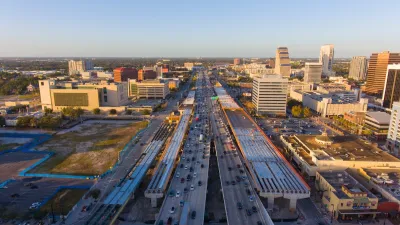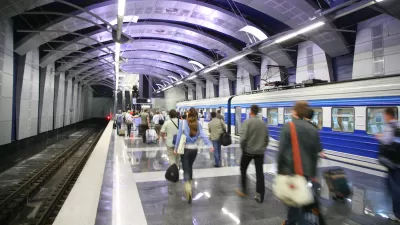The report calls for a wholesale overhaul of U.S. transportation policy to redress the damages caused by decades of auto-centric development.
Divided by Design, a new report from Smart Growth America, highlights the inequities built into the U.S. transportation system and calls for “a fundamental change to the overall approach to transportation.”
Past decisions, including routing the Interstate Highway System through communities of color, dividing and often demolishing them in the process, still shape our built environment. And most importantly, the foundation of the modern transportation program was built on models, measures, and standards with roots in this era.
The report notes that “Because it is difficult and unsafe to reach daily needs without a vehicle in much of the United States, transportation has long acted as an economic barrier in the United States.” Thanks to the perpetuation of car-oriented infrastructure, “Fewer than 10 percent of Americans currently live within walking distance of frequent transit, like buses or metro trains.”
Using Washington. D.C. and Atlanta as examples, the report quantifies the damage created by urban highways and compares it to the different development paths of neighborhoods where planned freeways were never built.
The report calls for sweeping changes in transportation policy. “Small, niche, siloed efforts … cannot repair past damage or keep up with the new barriers being created by new projects. To create a system that serves everyone and halts the practice of benefiting certain people at the expense of others, we need a new set of governing principles, standards, models, and measures, embedded in every single project and program.” According to the report, “Our scales don’t need rebalancing, they need replacing.”
FULL STORY: Divided by Design

Trump Administration Could Effectively End Housing Voucher Program
Federal officials are eyeing major cuts to the Section 8 program that helps millions of low-income households pay rent.

Planetizen Federal Action Tracker
A weekly monitor of how Trump’s orders and actions are impacting planners and planning in America.

Ken Jennings Launches Transit Web Series
The Jeopardy champ wants you to ride public transit.

California Invests Additional $5M in Electric School Buses
The state wants to electrify all of its school bus fleets by 2035.

Austin Launches $2M Homelessness Prevention Fund
A new grant program from the city’s Homeless Strategy Office will fund rental assistance and supportive services.

Alabama School Forestry Initiative Brings Trees to Schoolyards
Trees can improve physical and mental health for students and commnity members.
Urban Design for Planners 1: Software Tools
This six-course series explores essential urban design concepts using open source software and equips planners with the tools they need to participate fully in the urban design process.
Planning for Universal Design
Learn the tools for implementing Universal Design in planning regulations.
Ada County Highway District
Clanton & Associates, Inc.
Jessamine County Fiscal Court
Institute for Housing and Urban Development Studies (IHS)
City of Grandview
Harvard GSD Executive Education
Toledo-Lucas County Plan Commissions
Salt Lake City
NYU Wagner Graduate School of Public Service





























